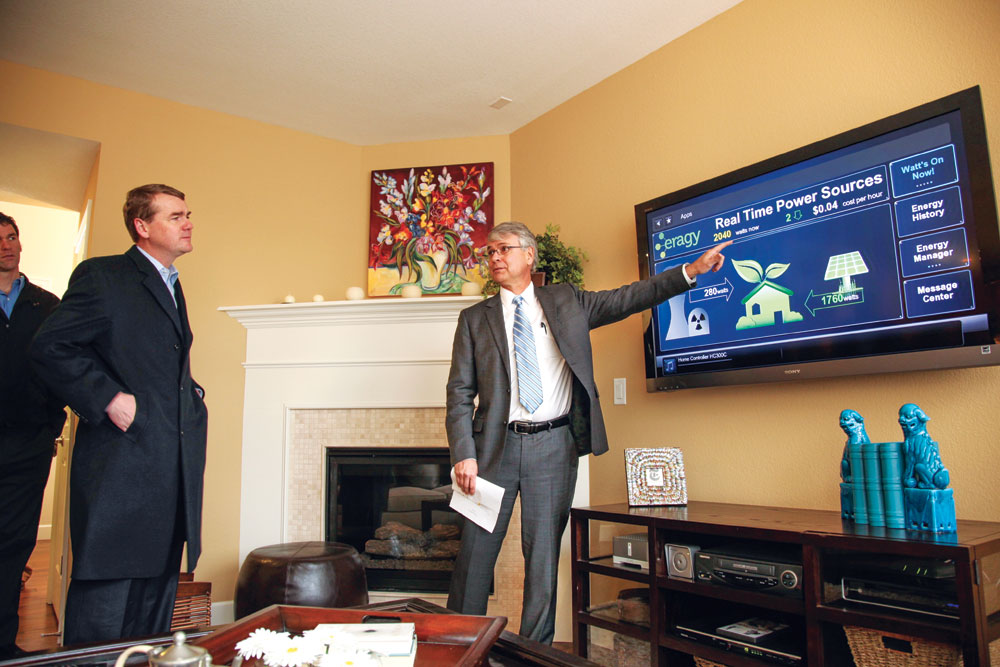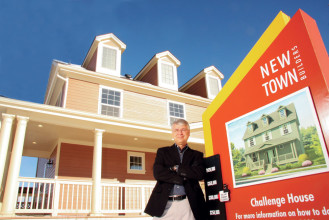![]() The Front Porch, in our October issue, published the story of how the Green Book, Stapleton’s Development Plan, came to be and what it was all about. That plan projected about 8,000 for-sale homes and 4,000 rentals—and it included a number of lofty ideas for that new community that people didn’t understand in the ’90s, when the plan was written. One of those lofty ideas was sustainability. People then didn’t even know what it meant. Another idea was a diverse housing mix in every neighborhood, including affordable housing. Affordable housing, it turns out, is a wonderful idea that is difficult to implement.
The Front Porch, in our October issue, published the story of how the Green Book, Stapleton’s Development Plan, came to be and what it was all about. That plan projected about 8,000 for-sale homes and 4,000 rentals—and it included a number of lofty ideas for that new community that people didn’t understand in the ’90s, when the plan was written. One of those lofty ideas was sustainability. People then didn’t even know what it meant. Another idea was a diverse housing mix in every neighborhood, including affordable housing. Affordable housing, it turns out, is a wonderful idea that is difficult to implement.

Senator Michael Bennet visited one of Gene Myers’ net-zero homes in January 2012 when he was proposing a bill that allowed federal mortgage loan agencies to consider a homeowner’s expected energy costs when determining the homeowner’s ability to make monthly mortgage payments.
Buyers who don’t know what sustainability is don’t put it on their “must have” list. And affordable housing comes with lots of strings attached—finding both financing and eligible buyers. Why would a homebuilder choose to pursue those goals?
Gene Myers, whose company has built approximately 1,000 of the homes in Stapleton so far (100 of them affordable), says sustainability was not high on buyers’ lists of reasons to buy a home in the early ’90s when he started down that path. “Hardly anyone was that interested,” he says.
The company’s efforts have been rewarded with being the nation’s first homebuilder to win the Grand Award from the U.S. Department of Energy for housing innovation three years in a row. “The innovation is happening with the Department of Energy and in national laboratories,” says Myers. “What we are is an adopter of that technology and an implementer in a way that makes it affordable for everyday people.”
Why take on these challenges? “Don’t we all want to feel like we go to work every day and do something that matters?” says Myers. As a local builder, he feels his company has a stake in the community and its goals. “Someone needs to step up and make these things happen, so we’re motivated by that … It’s a daunting task to build a great community that … includes homes people can be proud of, that provide stability and the ability to thrive.”
“Ultimately what you’re after is building homes that are an asset to the neighborhood and will inspire pride of ownership,” says Myers. When it comes to building affordable homes, there is a gap between what it costs to build and what buyers who qualify for the affordable program can pay. At Stapleton, Myers says, Forest City has worked with him to finance that gap, “So that overcomes the biggest obstacle in the production of affordable housing, bar none.”

Gene Myers is pictured in Dec. 2008 with a home his company, together with donations from subcontractors and land from Forest city, contributed. Its sale resulted in about $300,000 for sending city youth to college preparatory middle and high schools in the metro area.
The other challenge in affordable housing is buyers’ financing. “It’s an interesting challenge to find homebuyers who have strong credit, who make enough money to qualify for a mortgage, but don’t make so much that they don’t qualify under the affordable housing guidelines,” says Myers.
Myers says his next challenge is to focus on the health impacts of building materials while maintaining a focus on energy efficiency. “It’s our belief that there’s science that backs up the notion that the (indoor) environment in which we live has a connection to health,” he says, adding that EPA Indoor Plus guidelines call for reducing or eliminating toxins found in almost all new homes including adhesives, carpeting, carpet padding, cabinets, paint and wood finishes. “It also includes the proper introduction of fresh air into the very tight, energy-efficient homes we’re building, and management of the biohazards of mold and radon ventilation.” While it can be difficult to find suppliers to provide healthier materials, Myers says it can be done and doesn’t add much to the final cost of the home. “It’s implementing the best practices that have come from the U.S. E.P.A.,” says Myers.
Myers’ homebuilding business started out as Green Tree Homes in 1992. The business name then changed to New Town Builders, which has been building at Stapleton since the development started. To reflect his future focus on a healthful indoor environment, he is now changing the company’s name to Thrive. “We are, at the essence, environmentalists … and we want to see people thrive with the housing we provide. Nowhere is it more impactful for a family than in the affordable housing we build,” Myers says, as he takes on the construction of 145 new affordable homes north of I-70 on Central Park Blvd.



0 Comments